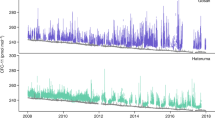Abstract
An in-situ GC-ECD system was used to measure halocarbons at Shangdianzi (SDZ) GAW regional station. In this paper, we reported observational results of atmospheric CFC-11 (CCl3F) mixing ratios from April 2007 to March 2008. The CFC-11 time series showed large variability. Approximately 62% observed values were filtered as non-background data. The median, 10% and 90% percentiles of CFC-11 background mixing ratios were 245.4 ppt (10−12 mol/mol), 244.6 ppt and 246.1 ppt, respectively; whereas those of non-background CFC-11 mixing ratios were 254.7, 246.6 and 272.1 ppt, respectively. Significant differences in background and non-background CFC-11 mixing ratios were observed between summer and autumn, mainly because of the CFC-11 stored in foam being prone to atmospheric release in hot seasons. Comparison of the SDZ data with the five AGAGE stations suggested agreement with mid-high latitude Northern Hemisphere stations MHD, THD and RPB. The SDZ data were higher than that of Southern Hemisphere stations CGO and SMO. Higher CFC-11 mixing ratios measured in different seasons were always associated with winds from the W-WSW-SW sector, indicating that the airflow coming from this wind sector has a positive contribution to CFC-11concentrations. The CFC-11 mixing ratios were higher in autumn and summer than in spring and winter, in which its mixing ratios were very close to the atmospheric background level. This was happened especially when airflow originated from the NNE-NE-ENE-E sector, indicating the air masses coming from these wind directions was relatively clean.
Similar content being viewed by others
References
Molina M, Rowland F S. Stratospheric sink for chlorofluoromethanes: Chlorine catalyzed destruction of ozone. Nature, 1974, 249: 810–812
State Environmental Protection Administration. National Program for Phase out of Ozone-depleting Substances (in Chinese). 2000. http://www.tobaccoinfo.com.cn/uploadpdf/cfcfujian/gjfa.pdf
Li J, Wang J, Li H, et al. The production and release of CFCs from coal combustion. Acta Geol Sin, 2003, 77: 81–85
Ravishankara A R, Solomon S, Turnipseed A A, et al. Atmospheric lifetimes of long-lived halogenated species. Science, 1993, 259: 194–199
Prinn R G, Weiss R F, Fraser P G, et al. A history of chemically and radiatively important gases in air deduced from ALE/GAGE/AGAGE. J Geophys Res, 2000, 105: 17751–17792
Butler J H, Battle M, Bender M, et al. A twentieth century record of atmospheric halocarbons in polar firn air. Nature, 1999, 399: 749–755
Montzka S A, Butler J H, Elkins J W, et al. Present and future trends in the atmospheric burden of ozone-depleting halogens. Nature, 1999, 398: 690–694
World Meteorological Organization. Scientific Assessment of Ozone Depletion: 2006. Global Ozone Research and Monitoring Project Report No. 50. Geneva: World Meteorological Organizatio, 2007. http://www.wmo.int/pages/prog/arep/gaw/ozone_2006/ozone_asst_report.html
Barletta B, Meinardi F S, Simpson I J, et al. Ambient halocarbon concentrations in 45 Chinese cities. Atmos Environ, 2006, 40: 7706–7719
Chan C Y, Tang J H, Li Y S, et al. Mixing ratios and sources of halocarbons in urban, semi-urban and rural sites of the Pearl River Delta, South China. Atmos Environ, 2006, 40: 7331–7345
Zhang F, Wang X M, Yi Z G, et al. Ambient levels of four trace Chlorofluorocarbons (CFCs) in the Pearl River Delta by Pre-Concentration-GC-MS (in Chinese with English abstract). Environ Sci, 2007, 34: 19–24
Bing S L, Chung B C. The relationship of meteorological and anthropogenic factors to time series measurements of CFC-11, CFC-12, and CH3CCl3 concentrations in the urban atmosphere. Atmos Environ, 2008, 42: 7706–7717
Xiu T Y, Wang Y S, Sun Y, et al. Trends and variation of CFC-11 in the atmosphere of Beijing (in Chinese with English abstract). Environ Sci, 2005, 26: 1–6
Dajun Q. Decline in the concentrations of chlorofluorocarbons (CFC-11, CFC-12 and CFC-113) in an urban area of Beijing, China. Atmos Environ, 2007, 41: 8424–8430
Chang C C, Lai C H, Wang C H, et al. Variability of ozone depleting substances as an indication of emissions in the Pearl River Delta, China. Atmos Environ, 2008, 42: 6973–6981
Wang S B, Tang X Y. Preliminary analysis of atmospheric halocarbons in Beijing area (in Chinese with English abstract). Acta Sci Circumstantiae, 1993, 13: 127–134
Wang J L, Chang C J, Lin Y H. Concentration distributions of anthropogenic halocarbons over a metropolitan area. Chemosphere, 1998, 36: 2391–2400
Zhou L X, Liu L X, Zhang X C, et al. Preliminary results on network observation of greenhouse gases at China GAW stations (in Chinese with English abstract). J Appl Meteorol Sci, 2008, 19: 641–645
Yao B, Zhou L X, Zhang F, et al, In-situ measurement of atmospheric halogenated greenhouse gases using GC-ECD method (in Chinese with English abstract). Environmen Chem, 2010, 29: 1159–1163
Vollmer M K, Zhou L X, Greally B R, et al. Emissions of ozone-depleting halocarbons from China (SOM). Geophys Res Lett, 2009, doi: 10.1029/2009GL038659
Reimann S, Vollmer M, Folini D, et al. Observations of long-lived anthropogenic halocarbons at the high-Alpine site of Junfraujoch (Switzerland) for assessment of trends and European sources. Sci Total Environ, 2007, doi: 10.1016/j.scitotenv.2007.10.022
Hu J, Zhao L, Zhang S, et al. Future of the production and consumption of CFC in China. Environ Protection, 2005, 7: 22–24
Palmer P, Jacob D, Mickley L, et al. Eastern Asian emission of anthropogenic halocarbons deduced from aircraft concentration data. J Geophy Res, 2003, 108: 4573
Author information
Authors and Affiliations
Corresponding author
Rights and permissions
About this article
Cite this article
Zhang, F., Zhou, L., Yao, B. et al. In-situ measurement of atmospheric CFC-11 at the Shangdianzi Global Atmosphere Watch (GAW) Regional Station. Sci. China Earth Sci. 54, 298–304 (2011). https://doi.org/10.1007/s11430-010-4118-5
Received:
Accepted:
Published:
Issue Date:
DOI: https://doi.org/10.1007/s11430-010-4118-5



